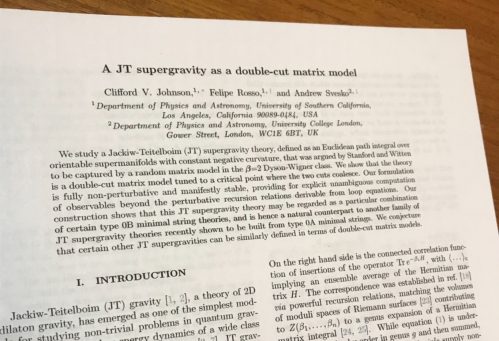
Yesterday I submitted (with collaborators Felipe Rosso and Andrew Svesko) a new paper to the arXiv that I’m very excited about! It came from one of those lovely moments when a warm flash of realisation splashed through my mind, and several fragments of (seemingly separate things) that had been floating around in my head for some time suddenly all fit together. The fit was so tight and compelling that I had a feeling of certainty that it just “had to be right”. It is a great feeling, when that happens. Of course, the details had to be worked out, and everything checked and properly developed, new tools made and some very nice computations done to unpack the consequences of the idea… and that’s what resulted in this paper! It is a very natural companion to the cluster of papers I wrote last year, particularly the ones in May and June.
What’s the story? It’s all about Jackiw-Teitelboim (JT) gravity, a kind of 2D gravity theory that shows up rather generically as controlling the low temperature physics of a wide class of black holes, including 4D ones in our universe. Understanding the quantum gravity of JT is a very nice step in understanding quantum properties of black holes. This is exciting stuff!
Ok, now I’ll get a bit more technical. Some background on all this (JT gravity, matrix models, etc), can be found in an earlier pair of posts. You might recall that in May last year I put out a paper where I showed how to define, fully non-perturbatively, a class of Jackiw-Teitelbiom (JT) supergravity theories that had been defined in 2019 in a massive paper by Stanford and Witten (SW). In effect, I showed how to build them as a particular combination of an infinite number of special “minimal string” models called type 0A strings. Those in turn are made using a special class of random matrix model based on […] Click to continue reading this post →
























